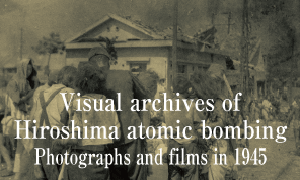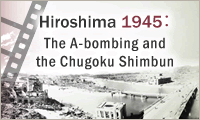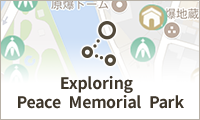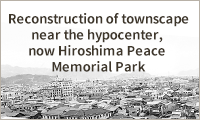Hiroshima: 70 Years After the A-bombing: Close-range Survivors 1
Jul. 17, 2014
Kiyoko Imori, 80: Living with her husband
At Honkawa National School at time of A-bombing
Exposed to an estimated 4.9 sieverts of radiation: Several kinds of cancer
Kiyoko Imori, 80, was at Honkawa National School (now Honkawa Elementary School in Naka Ward), about 410 meters from the hypocenter, at the time of the atomic bombing. She was the only student at the school to survive. She now lives in a neighborhood in Yokohama beside Odori Park, which runs through the port city’s downtown area.
When I went upstairs to her room, Ms. Imori greeted me from her bed. “I’m sorry I look like this when you’ve come all the way from Hiroshima,” she said. Her husband, Hiroteru, 79, said, “She can’t move from the waist down, but her brain and her mouth work great.”
Since returning home last October after being hospitalized for pneumonia and hyperglycemia, Ms. Imori has been bedridden. Her husband provides care for her, getting up at 4 a.m. every day to give her an insulin shot. He also cooks for her, changes her diaper pads and checks her blood pressure. She uses a local day service center to bathe three times a week. The couple has no children.
“I guess I was just very lucky.” Perhaps on account of her physical condition, Ms. Imori occasionally spoke in a detached manner about the events of August 6, 1945.
Her maiden name was Tsutsui, and the family home was in Sorazaya-cho (now Honkawa-cho in Naka Ward). At the time of the atomic bombing, Ms. Imori was 11 years old and in the sixth grade. She did not participate in the group evacuation to the countryside for children in the third grade and up but attended Honkawa National School, which was a three-story ferroconcrete building. In 1988 part of the school building that survived the A-bombing was made into a Peace Museum, which is visited by many students on school trips. According to the “Record of the A-Bomb Disaster” published by the City of Hiroshima, 218 students were killed instantly, but full details of the casualties remain unknown.
Ms. Imori said she remembers clearly what happened. “I was on the first floor of the building on the north side of the school, in the area where we took our shoes off,” she said. “I came to school with a classmate from the neighborhood. Just after we changed our shoes, everything went black.” A faint light shone through the darkness, and they went out to the playground. It was a sea of fire. The surface temperature at the hypocenter was between 3,000 and 4,000 degrees Celsius. There was a back draft from the shock wave, and the wooden houses throughout the area burst into flames.
At the urging of two female teachers who came out of the school building, which was engulfed in flames, Ms. Imori and her classmate went into the Honkawa River beside the school. Bodies came floating by one after another. “It wasn’t scary,” she said. “We just got into the water.” She said she doesn’t remember when she parted from the teachers, where or how she walked or the location of the farm she arrived at after being picked up along the way by a truck. Family members came to get the classmate who was with her, but Ms. Imori learned later that her classmate died soon after that.
The remains of Ms. Imori’s father, Shinichi, 56; mother Tsuru, 44; and younger brother, Noriyuki, 4, were never found. She went to live with an aunt, and after graduating from junior high school she lived and worked at a beauty parlor in the northern part of Hiroshima Prefecture. She later moved to Yokohama in search of work and became acquainted with Hiroteru’s mother there. She and Hiroteru married when she was 30.
“He was understanding about my being an atomic bomb survivor,” she said. Memories of the days when they became acquainted brought a smile to her face. Her husband was a designer for an electrical company, while Ms. Imori worked at a pencil factory. After suffering through two miscarriages, they built a home together.
But Ms. Imori was unrelentingly afflicted by illnesses related to the atomic bombing. A tumor in her pancreas that was found when she was 40 was benign, but she has suffered from thyroid cancer, colon cancer and, at 67, meningioma. Three years later she also had surgery for a neurilemoma. Based on the ratio of her chromosomal abnormalities, it is estimated that Ms. Imori was exposed to 4.9 sieverts of radiation, well over the semi-lethal dose of 4 sieverts.
While in the hospital last year she became critically ill. Her husband told the hospital of her desire for an autopsy. “She wants her body, which is plagued by disease, to be examined after her death too.” When he noticed that she looked tired, Ms. Imori’s husband spoke on her behalf.
When she reached her 70s, Ms. Imori began talking about her A-bombing experiences in Yokohama and Tokyo. “My husband said that because I miraculously survived I had a duty to tell people about the horrors of the atomic bomb and war,” she said. “We talked about it and agreed that I should carry out this mission as long as I live.” That is one reason she also agreed to be interviewed despite her poor health. Hiroteru was baptized when he was young, and Ms. Imori followed suit 15 years ago.
◇
This series follows the lives of those who were within 500 meters of the hypocenter at the time of the atomic bombing and miraculously survived.
(Originally published on June 2, 2014)









